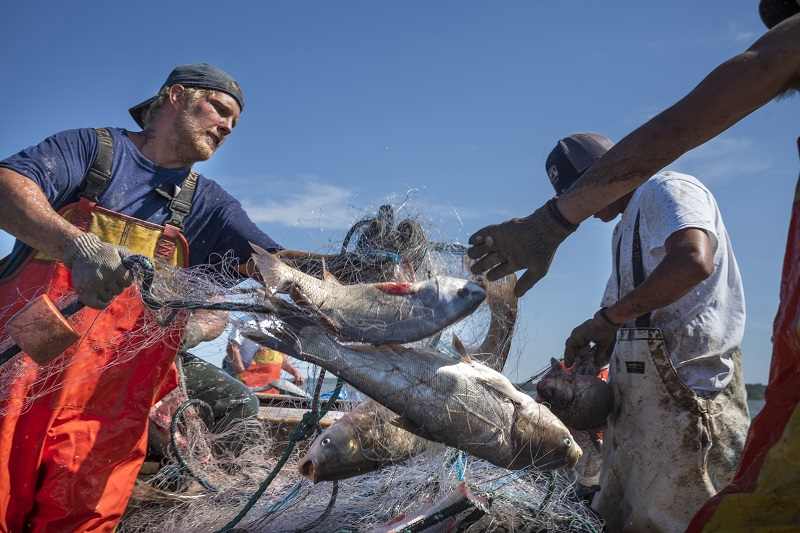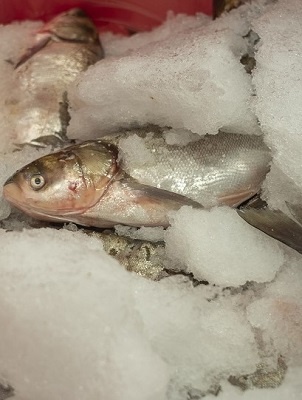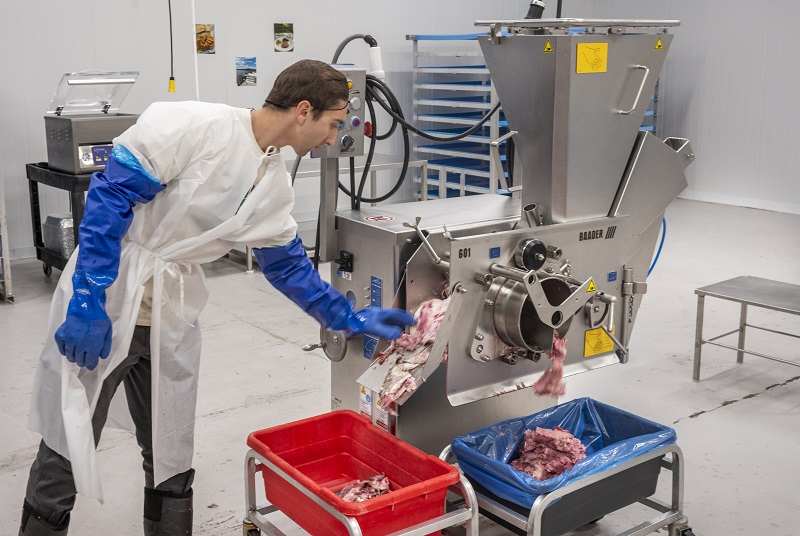
Fishing boat deckhand Tristan Wetzel, left, wrestles a net bearing silver Asian carp harvested in the Illinois River on June 20, 2022. Illinois officials, in an effort to nurture a market for the fish, will unveil a name change for the fish.
12:46 JST, June 26, 2022
As a brand, Asian carp have two big problems: The name strikes many as both racially insensitive and decidedly unpalatable — a trash fish.
How about some “copi” instead?

A silver Asian carp harvested in the Illinois River on June 20, 2022, is packed in ice at Sorce Enterprises in East Peoria, Ill. Monday, June 20, 2022.
In a marketing event Wednesday, Illinois officials announced the focus-group-approved name for the prolific invasive species. With the fresh consumer brand, they are seeking to gut the fish’s numbers and reduce the looming ecological threat it poses to the Great Lakes.
Soon, they hope, folks will be noshing on copi sliders and cooking up copi tacos, eating into the invader’s population.
” ‘Copi’ rose to the top. It’s kind of fresh, maybe kind of Mediterranean,” Kevin Irons, assistant fisheries chief at the Illinois Department of Natural Resources, said of the two-year name search. “Copi sounded like a fish.”
That’s copi as in copious, which from an environmental perspective is the problem with these fish.
Introduced from Asia in the 1960s to control weeds and algae, four voracious species — silver, bighead, grass and black carp — escaped from ponds in the South and have exploded in numbers along the Mississippi River and its far-reaching tributaries.
Mighty American rivers that once teemed with a diversity of species are now roiling with millions of invasive carp, the largest of which, at 110 pounds, can outweigh a person. Videos of the big, silvery fish rocketing out of the water along the Illinois, Missouri and Ohio rivers have been going viral for years.
Collectively known as Asian carp, they are now at the doorstep of the Great Lakes, massed in significant numbers less than 50 miles from Lake Michigan.
Biologists fear that if the fish get there, they will vacuum up the plankton that form the foundation of the food web, wreaking havoc on an already invaded, disrupted Great Lakes ecosystem that nevertheless supports a $7 billion sport fishing industry.
Illinois officials are betting that consumer demand will winnow that carp supply. They tout the fish’s mild flavor, its abundance of omega-3 fatty acids and its lower levels of mercury than in most other fish, emphasizing that these species, unlike the common carp, are not bottom feeders.
“This is not your grandfather’s carp,” Irons said. “It is not the one that is rooting around down in the mud. Because they are eating high in the water column, there are lower levels of contaminants.”
Biologists estimate that the Illinois River holds 20 million to 50 million pounds of the fertile invaders just waiting to be exploited and, they hope, overfished.
Building demand for the fish would drive a resurgence of an Illinois River fishing industry that was once one of the nation’s most productive, the thinking goes. This would provide jobs to communities that need them, and tap into a protein source that could help relieve food insecurity while reducing the single greatest ecological threat to the Great Lakes, Irons said.
“It checks all the boxes,” he said.
Chicago chef Brian Jupiter, a two-time James Beard Award semifinalist and a winner of the Food Network’s “Chopped” competition, revealed the new name Wednesday.
In an interview days before the event, Jupiter said he planned to offer the fish at his New Orleans-influenced Ina Mae Tavern, perhaps in a po’ boy sandwich made with copi fish cake.
“It’s a flaky fish that has white flesh; the flavor is good and mild,” he said. “It does have a lot of bones, so that makes it challenging.”
Most past attempts to market the fish have run into trouble when they hit those bones. The carp’s skeleton is composed of an intricate lacework of intermuscular bones that branch off in a Y shape deep inside the flesh of the fish, creating a vexing puzzle for a fillet knife.
Those who do cut boneless pieces say a 40-pound carp produces less than four pounds of fish strips a few inches long and only about a quarter-inch thick.
Because of that, the new marketing push focuses on minced fish, produced by a washing-machine-size contraption that squeezes the white flesh from the bone. Although the result resembles ground turkey, it is technically not ground.
Persuading consumers to embrace minced fish may pose a challenge.
“There are certain communities that are more amenable to minced fish, but I think this will socialize it,” Irons said. “Maybe this will be the advantage of using this as the first fish: Not only are you introducing copi as a great dinner protein, but you also might say, ‘I never thought of using minced fish.'”
Jupiter said he was at first perplexed when he received samples.
“I was like, ‘What’s that?’ ” he said. “That was the last thing I was wanting to work with in terms of the cuts they sent. But I did find it very easy to use in the cake format. As kids, we ate fish sticks. It allows you a lot of versatility.”
His is one of about two dozen restaurants, stores and wholesalers lined up to begin selling copi on Wednesday. Recipes will be available at ChooseCopi.com.
A 2018 state report on the commercial potential of the top-feeding invasive carp noted that consumers consider them “trash fish,” associating them with the bottom-feeding common carp introduced to the United States in the mid-19th century.
Many in the renaming effort quip that carp is a four-letter word. They also cite precedent: orange roughy? It was once known as slimehead. Chilean sea bass? Formerly Patagonian toothfish.
Even Asian carp have undergone previous brand makeovers. Colloquially, they have been called river rabbits and Illinois bass. An attempt in 2010 aimed to call them Kentucky tuna. A new carp processing plant on the Illinois River calls its product shiruba (silver in Japanese). And Louisiana chef Philippe Parola trademarked Silverfin and has been working for more than a decade to build a business selling it.
Parola, who began cooking invasive rodents in the 1990s by developing recipes for nutria, said he welcomes the push for copi, believing it can reduce ecological harm and win consumers over to his Silverfin as well. But he warned that it will not be easy. “Many have tried,” he cautioned.
To make “copi” stick, Illinois will trademark the name and is seeking to have it adopted by the U.S. Food and Drug Administration. For now, fish labeled copi must be identified as carp, Irons said.
Some previous moves to change the name have focused on racial sensitivity. The U.S. Fish and Wildlife Service stopped using the name last year to “move away from any terms that cast Asian culture and people in a negative light,” one official explained.
“There seems to be a stigma on multiple levels with this fish,” said Jayette Bolinski, spokeswoman for the Illinois Department of Natural Resources. “The primary reason we are changing the name is because research shows consumers associate Asian carp with a fish that is unappealing, unappetizing. Of course, removing the racial reference in the name is another reason why we are doing this.”
If a name change does stimulate an appetite for the fish, an industry of workers and infrastructure will be needed to satisfy it. A nascent commercial carp-fishing industry has grown around the Peoria Pool, a 73-mile stretch of the Illinois River where the fish breed prolifically.
In 2020, Sorce Feshwater Co. opened a processing plant on the shore of the pool and last year handled about 5 million pounds of invasive carp, said Roy Sorce, the company’s president.
Sorce charges $5.95 per pound for minced fish and up to $10 per pound for the strips, because they are hand cut.

Sorce Freshwater Company manager Tony Sorce monitors a bone separator as a fish’s skin, scales and bone are removed, leaving only the protein.
A couple of dozen fishermen have banded together to form the Midwest Fish Co-Op.
All agree that the industry has not achieved critical mass and will need more people to catch the fish. Clint Carter, a fisherman whose parents also worked the Illinois, said it requires at least $170,00 to buy the boat, truck and equipment needed to enter the business.
“There are a lot of people who look at this as a free protein source, but there are a lot of economics that need to be taken care of to make this thing go,” he said.
Carter has been offering “Asian carp” at his fish shop in Springfield, Ill. — three-quarters of a pound of fried boneless strips, pickles and onions on bread for $7.99. He sold four orders on a recent Saturday.
“I have probably fed 10,000 people samples over the years, and I have had maybe two people say they don’t like it,” Carter said. “It is mostly that mental stigma of it being carp.”
Sorce opened the processing plant because he became convinced that the fish could help alleviate rising food insecurity around the world. That market has not yet adopted it, however. One major hunger relief organization likes his product but cannot take it because its rules prevent using minced fish, he said, something that he thinks must change.
For now, he reluctantly has to place some hope in the pet food market, which already uses some of the fish.
“I love my dog, but this fish could literally solve a lot of the problems with people in need, for hungry people,” Sorce said.
In the meantime, the population grows, increasing the threat to the Great Lakes.
The lakes are connected to the Mississippi River basin through canals completed in 1900 to reverse the flow of the Chicago River, which sent the city’s sewage away from its drinking water source in Lake Michigan.
To keep the fish from swimming through the channel, engineers in 2002 switched on the first of several electric underwater barriers about 37 miles from the lake.
A more ambitious barrier project is underway at Brandon Road Lock and Dam, near Joliet, Ill., identified by the U.S. Army Corps of Engineers as the “critical pinch point” between the Mississippi River and the Great Lakes.
The $858 million project, now in the design phase, will include yet another electric barrier but will add fish-frightening underwater acoustics and an intimidating curtain of bubbles.
Planners say their barriers have a better chance of success if the fish population is first reduced by a thriving fishery.
“With commercial fishing, what we want to do is attack the population that is coming up the Illinois River and fish those invasive species out of there and keep the population low or kept as far downstream as possible,” said Andrew Leichty, the Brandon Road project manager.
Marc Gaden, legislative liaison for the Great Lakes Fishery Commission, called the risk from the fish “grave.” Rebranding the carp to foster a fishing industry is a helpful step, he said.
“Make lemonade if you have lemons,” Gaden said, “and maybe fish them out to at least keep a lid on them.”

Fisherman Brett Whitsitt, left, steers the boat as deckhands Tristan Wetzel, center, and Brandon Barner release nets on the Illinois River on June 20, 2022.
"News Services" POPULAR ARTICLE
-

American Playwright Jeremy O. Harris Arrested in Japan on Alleged Drug Smuggling
-

Japan’s Nikkei Stock Average as JGB Yields, Yen Rise on Rate-Hike Bets
-

Japan’s Nikkei Stock Average Licks Wounds after Selloff Sparked by BOJ Hike Bets (UPDATE 1)
-

Japan’s Nikkei Stock Average Buoyed by Stable Yen; SoftBank’s Slide Caps Gains (UPDATE 1)
-

Japanese Bond Yields Zoom, Stocks Slide as Rate Hike Looms
JN ACCESS RANKING
-

Tokyo Economic Security Forum to Hold Inaugural Meeting Amid Tense Global Environment
-

Keidanren Chairman Yoshinobu Tsutsui Visits Kashiwazaki-Kariwa Nuclear Power Plant; Inspects New Emergency Safety System
-

Imports of Rare Earths from China Facing Delays, May Be Caused by Deterioration of Japan-China Relations
-

University of Tokyo Professor Discusses Japanese Economic Security in Interview Ahead of Forum
-

Japan Pulls out of Vietnam Nuclear Project, Complicating Hanoi’s Power Plans























